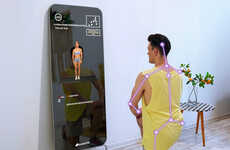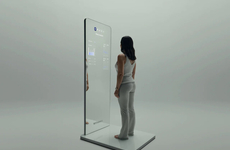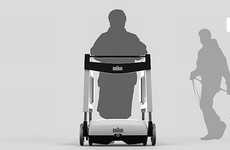
The Panasonic Digital Mirror Hopes to Transform Patient Rehabilitation
Omar Yusuf — September 5, 2011 — Social Good
The Digital Mirror, developed by Panasonic Electronics, has already been showcased throughout its native Japan and intends to hit markets later this year. Its purpose: to expedite and simplify the process of patient rehabilitation.
After a serious injury or accident, the process of acclimatizing your body to the stress of everyday life can be a long, torturous journey. In an attempt to make that journey as easy and encouraging as possible, Panasonic is rolling out its new Digital Mirror system. The full 42-inch mirror not only reflects the patient's image but superimposes a digital trainer onto the surface. The trainer illustrates -- through action and speech -- how to exercise and can change its regime depending on the patient's progress. The Digital Mirror could just as easily be introduced into gyms, allowing visitors to avoid expensive training fees.
So if you're going to hurt yourself, it might as well be in Japan and in the next fiscal quarter. By then, your personal digital trainer will be waiting!
After a serious injury or accident, the process of acclimatizing your body to the stress of everyday life can be a long, torturous journey. In an attempt to make that journey as easy and encouraging as possible, Panasonic is rolling out its new Digital Mirror system. The full 42-inch mirror not only reflects the patient's image but superimposes a digital trainer onto the surface. The trainer illustrates -- through action and speech -- how to exercise and can change its regime depending on the patient's progress. The Digital Mirror could just as easily be introduced into gyms, allowing visitors to avoid expensive training fees.
So if you're going to hurt yourself, it might as well be in Japan and in the next fiscal quarter. By then, your personal digital trainer will be waiting!
Trend Themes
1. Holographic Training - The use of holographic trainers to guide and motivate patients during their rehabilitation process.
2. Virtual Mirror Technology - The development and adoption of digital mirrors that superimpose a digital trainer onto the reflection of the user.
3. Personalized Exercise Regimes - The use of AI technology to adjust exercise routines based on individual progress and needs.
Industry Implications
1. Healthcare - The healthcare industry can explore the use of holographic trainers and virtual mirror technology to enhance patient rehabilitation programs.
2. Fitness - The fitness industry can incorporate digital mirrors and personalized exercise regimes to provide interactive and cost-effective training options.
3. Technology - The development and implementation of virtual mirror technology presents new opportunities for the technology industry to innovate in the field of augmented reality and AI.
2.6
Score
Popularity
Activity
Freshness























